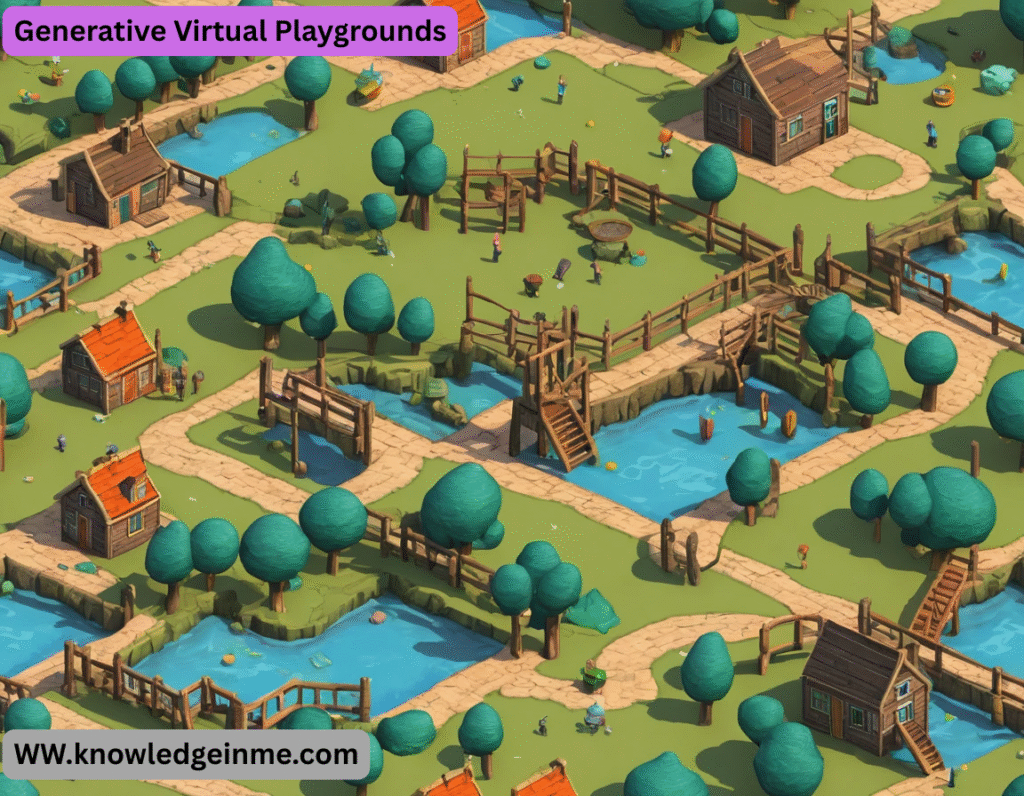Generative Virtual Playgrounds Generative Virtual Playgrounds represent an emerging frontier in interactive digital experiences, combining generative AI with immersive virtual environments to create dynamic, evolving spaces for play, learning, and creativity.
Procedurally Generated Content
- AI-generated landscapes, structures, and objects
- Infinite variation in playground layouts and challenges
Adaptive Gameplay
- Difficulty that scales to user skill level
- Personalized challenges based on player behavior
- Dynamic storytelling that responds to user choices
Creative Sandbox Elements
AI-assisted building tools
- Natural language interface for environment modification
- Shared creative spaces for collaborative world-building
Technological Foundations
- Generative AI Models: Combining LLMs with image/video generation for content creation
- Physics Engines: Realistic simulation of objects and environments
- Cloud Computing: Scalable infrastructure for persistent virtual worlds
- XR Technologies: Integration with VR/AR/MR for immersive experiences
Potential Applications
- Education: Interactive learning environments that adapt to student needs
- Therapy: Safe spaces for social skills development and exposure therapy
- Entertainment: Next-generation gaming experiences
- Urban Planning: Prototyping real-world spaces in virtual environments
Core Components of GVPs
AI-Powered World Generation
- Procedural Environments: Algorithms generate landscapes, cities, dungeons, or abstract spaces that never repeat.
- Neural Network Designers: AI like GANs (Generative Adversarial Networks) and diffusion models create textures, objects, and NPCs.
- Infinite Variation: No two play sessions are identical—terrain, weather, and challenges shift dynamically.
Adaptive Interaction & Storytelling
- NPCs with AI Personalities: Characters powered by LLMs (Large Language Models) engage in meaningful, unscripted dialogue.
- Player-Driven Narratives: The world reacts to choices, creating emergent storylines (e.g., a city evolves based on player decisions).
- Difficulty Scaling: AI adjusts challenges based on skill level, ensuring engagement without frustration.
User Co-Creation Tools
- Natural Language Commands: “Build a medieval castle with a moat” → AI generates it instantly.
- AI-Assisted Creativity: Sketch rough ideas, and the system refines them into polished assets.
- Shared Sandbox Mode: Multiplayer environments where users collaboratively shape the world.
Immersive Technologies
- Haptic Feedback: Touch sensations enhance realism (e.g., feeling virtual wind or textures).
- Neural Interfaces (Future): Direct brain-computer interaction for deeper immersion.
Potential Applications
Gaming & Entertainment
- Infinite Open Worlds: Games like Minecraft but with AI-generated quests, biomes, and lore.
- AI Dungeon Masters: Role-playing games where the AI dynamically crafts adventures.
Education & Training
- Historical Simulations: Walk through AI-reconstructed ancient Rome or experience pivotal moments.
- STEM Learning: Interactive physics/chemistry labs with generative experiments.
Therapy & Mental Health
- Exposure Therapy: Safe virtual spaces for overcoming phobias (e.g., fear of heights).
- Social Skills Training: AI-driven characters help users practice real-world interactions.
Urban Planning & Architecture
- AI-Generated City Prototypes: Test urban designs before real-world implementation.
- Community Co-Design: Citizens collaboratively shape virtual models of future projects.
Extended Technical Foundations
Generative AI Stack Powering GVPs
Multi-Modal Generation Models
- Text-to-3D (e.g., NVIDIA Omniverse, Open AI’s 3D-aware diffusion models)
- Audio-reactive environments (AI generating visuals synchronized to music)
- Physics-aware generation (objects with proper mass, friction, and material properties)
World Simulation Engines
- Neural physics engines (AI predicting complex interactions beyond rigid-body physics)
- Ecosystem simulations (flora/fauna with evolutionary behaviors)
- Weather/climate systems with butterfly-effect causality
Network Architecture
Distributed Generation
- Edge-computed elements (user’s device handles immediate interactions)
- Cloud-based persistent world state (global coherency)
- Peer-to-peer creativity sharing (user-generated content propagation)
Latency Masking Techniques
- Predictive generation (AI pre-rendering likely next environments)
- Graceful degradation (maintaining playability during computation spikes)
Advanced Interaction Paradigms
Natural Language as a Creative Interface
Precision Prompt Engineering
- Context-aware generation (“Make this castle look more ominous” adjusts lighting, textures, and architecture)
- Multi-step refinement (“Now add a secret underground tunnel leading to…”)
Voice-Driven Worldbuilding
Real-time vocal narration shaping environments
- Emotional tone detection influencing generation (excited speech → vibrant colors)
Embodied AI Agents
NPCs with Persistent Memory
- Characters that remember past interactions across sessions
- Evolving relationships based on cumulative experiences
Player-Configured Companions
- Customizable AI personalities through trait sliders
- Skill progression systems for synthetic entities
Emerging Use Cases
Cognitive Augmentation
Memory Palaces 2.0
- AI-generated mnemonic environments tailored to individual learning styles
- Dynamic visualization of complex information architectures
Flow State Inducement
- Environments that adapt in real-time to optimize user focus
- Biofeedback-integrated difficulty adjustment
Cultural Preservation
Living Digital Heritage
- AI-reconstructed historical sites with period-accurate NPCs
- Simulated traditional craftsmanship with haptic feedback
Language Revival Environments
- Immersive spaces for practicing endangered languages
- AI conversation partners with dialect variations
Technical Challenges Extended
Temporal Coherence
- Maintaining consistency in persistent worlds
- Resolving paradoxes in player-altered timelines
- Version control for collaboratively edited spaces
Computational Ethics
- Energy-efficient generation algorithms
- Carbon-aware rendering techniques
- Fair resource allocation in shared spaces
Reality Calibration
- Preventing dissociation effects
- Maintaining healthy virtual/physical boundaries
- Cross-reality continuity systems
- Future Evolution Pathways
Neuroadaptive Interfaces
- EEG-integrated environment modulation
- Subconscious preference detection
- Dream-state playground access
Quantum-Enhanced Generation
- Quantum noise-driven creativity
- Parallel universe simulation
- Instantaneous large-scale generation
Bio-Digital Hybridization
- DNA-influenced world generation
- Microbial computation integration
- Organic-digital aesthetic blending
- Implementation Roadmap
Current (2024-2026)
- Isolated prototype environments
- Basic generative building blocks
- Single-user experiences
Mid-Term (2027-2030)
- Persistent shared worlds
- Cross-platform continuity
- Advanced AI co-creation
Long-Term (2031+)
- Full-dive neural integration
- Self-sustaining virtual ecologies
- Reality-blurring experiences
- Ethical Framework Proposals
- Generative Content Provenance
- Blockchain-based creation trails
AI attribution standards
- Dynamic Content Rating
- Real-time age-appropriate filtering
- Cultural sensitivity adaptation
Existential Safeguards
- Anti-addiction architectures
- Identity preservation systems
Part 1: The Paradigm Shift – Beyond Games and Metaverses
- We stand at the precipice of a new ontological category – not games, not virtual worlds, but Generative Experience Ecosystems. These are living matrices where:
Reality is a Conversation
- Every interaction becomes a creative act. A child’s finger-painting alters the physics of clouds. A sigh transforms ambient music. The playground listens.
Time Becomes Malleable
- Environments remember and anticipate. Your yesterday’s abandoned sandcastle now stands weathered, inhabited by AI creatures that evolved to live in its cracks.
The Death of Prefab Content
- No more static assets. Every tree contains the seed of infinite forests. Each stone whispers its geological history and potential futures.
Part 2: The Technical Breakthroughs Required
The Five Pillars of Next-Gen GVPs
Cognitive GPUs
- Processors optimized for real-time latent space navigation
- Hardware that dreams (neuromorphic chips running diffusion models)
Emotional Physics
- Light that bends with mood
- Gravity responsive to collective anxiety/excitement levels
Protean Protocols
- Self-modifying networking stacks
- Quantum-entangled state synchronization
Biomorphic UI
- Interfaces that grow like vines
- Control schemes evolving through mimicry of user behavior
The Chaos Governor
- Anti-entropy systems maintaining playability
Dynamic stability thresholds
Part 3: The New Human Experience
Radical Play Taxonomy
- Ontological Play
- Experimenting with the nature of reality itself
- “What if sound was tactile?” becomes a playground setting
Temporal Sculpting
- Collaborating with your past/future selves
- Building monuments across timelines
Meta-Symbiosis
- Training AI companions that develop unique play styles
- Co-evolving with synthetic intelligences






